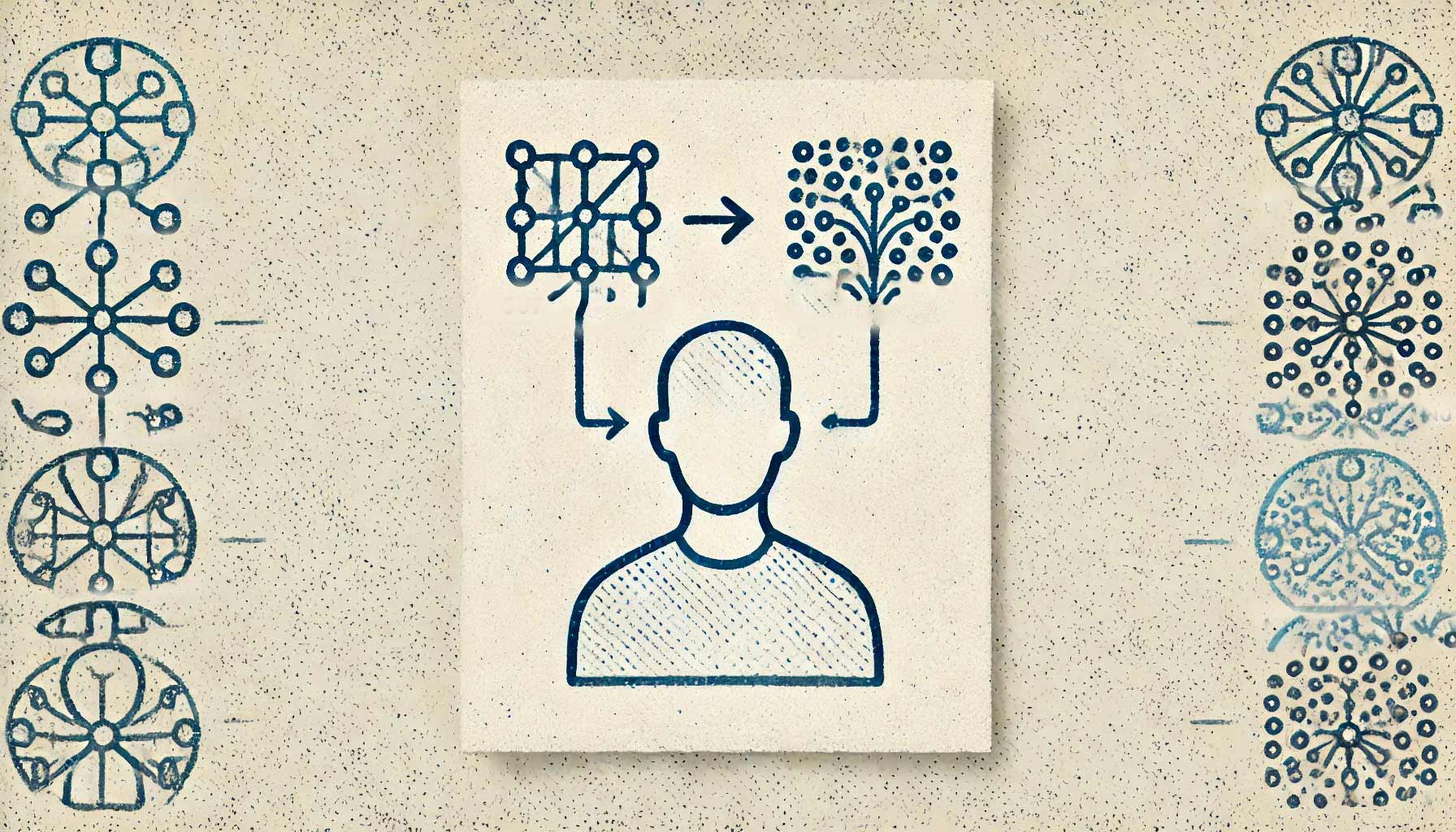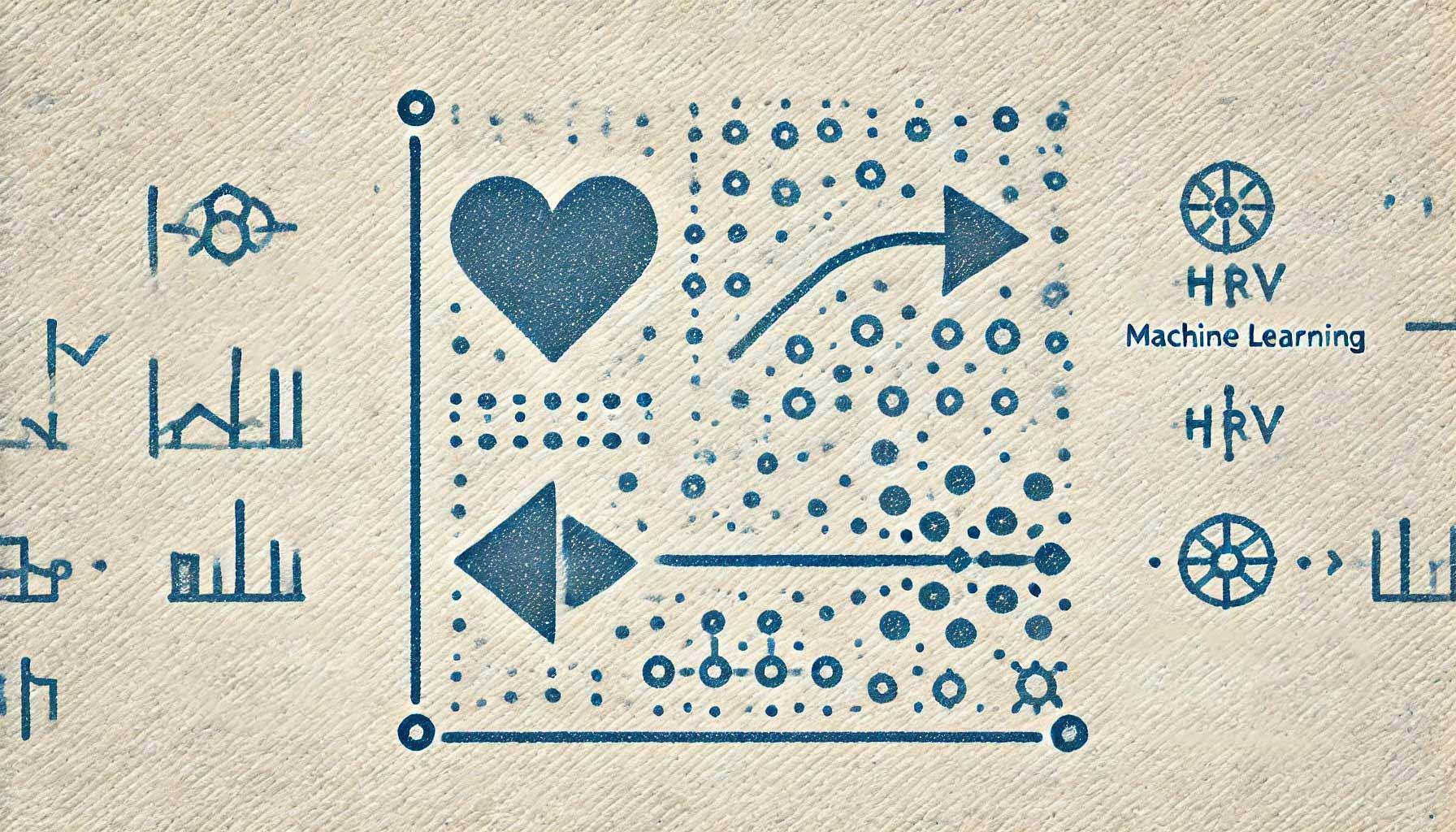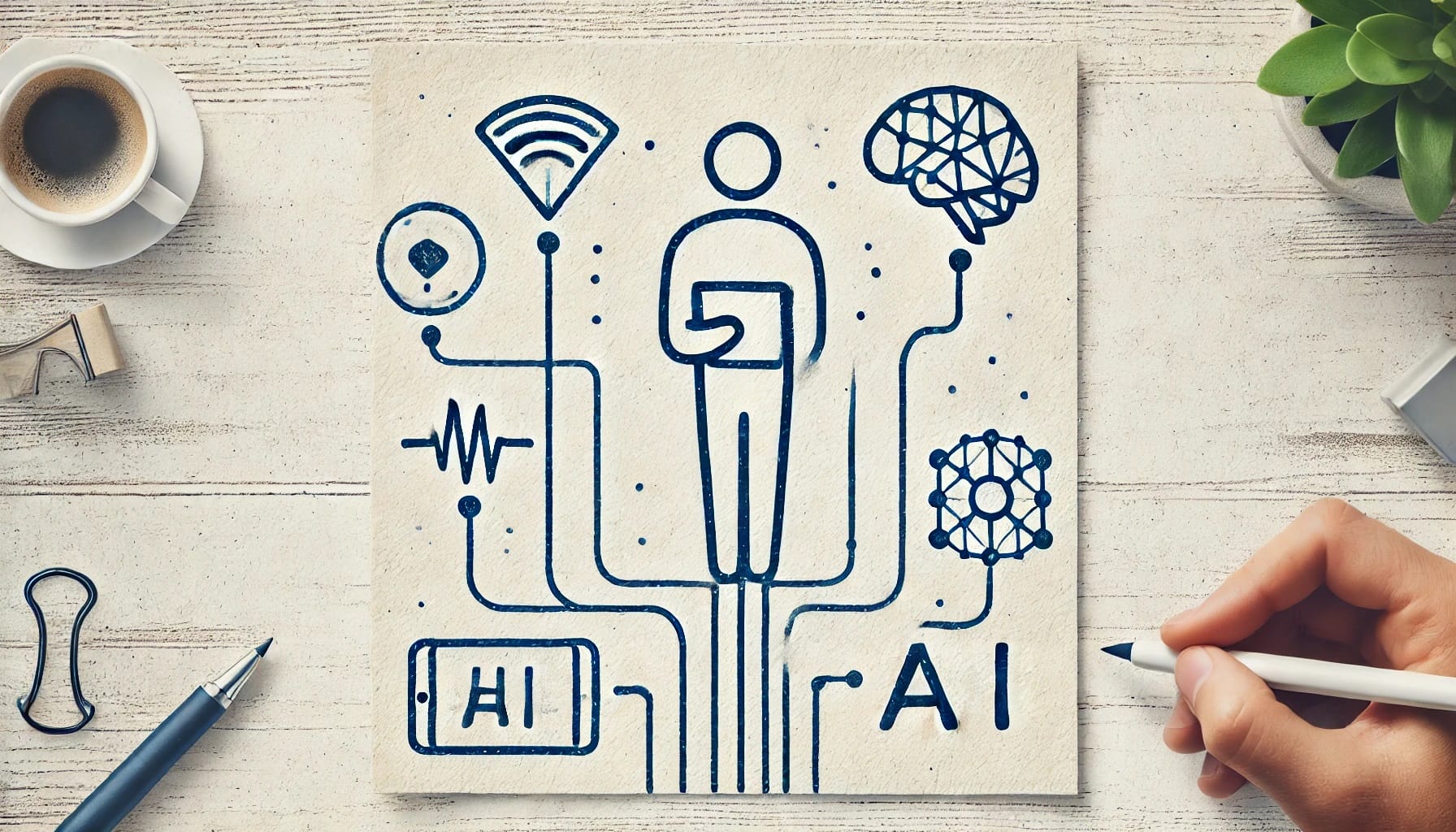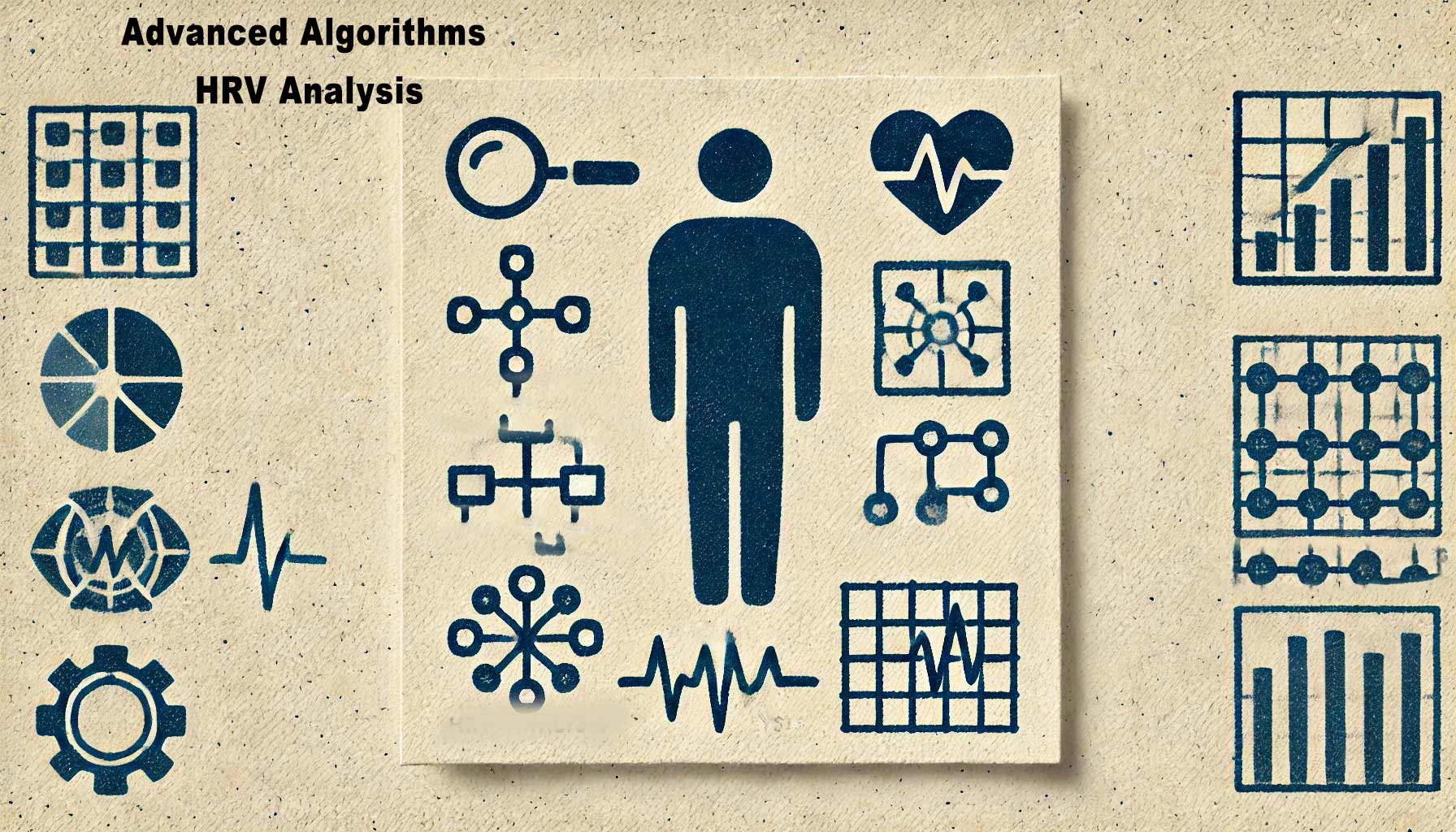I. Introduction
Advanced algorithms are transforming Heart Rate Variability (HRV) analysis, providing researchers with tools to uncover complex patterns and improve predictive accuracy. Traditional methods, such as time-domain, frequency-domain, and non-linear analyses, often struggle with large datasets, non-linear physiological signals, and integrating multimodal data. In contrast, advanced algorithms such as machine learning (ML) and deep learning (DL) techniques excel at modeling non-linear relationships, managing complex datasets, and boosting predictive accuracy. As HRV research becomes more data-intensive, advanced algorithms are essential for deriving meaningful insights from long-term studies.
This article reviews advanced algorithms in HRV analysis, highlighting their strengths, limitations, and practical applications to help researchers choose the best methods for their studies.

II. Traditional vs. Advanced Algorithms for HRV Analysis
A. Overview of Traditional Algorithms
Traditional HRV analysis methods include:
- Time-Domain Methods: Measure the variation in intervals between heartbeats (e.g., SDNN, RMSSD).
- Frequency-Domain Methods: Analyze the power distribution of different frequency bands (e.g., LF, HF) to assess autonomic balance.
- Non-Linear Methods: Capture the complexity and unpredictability of heart rate dynamics (e.g., Poincaré plots, sample entropy).
These methods have been invaluable for basic HRV analysis, offering insights into overall variability, autonomic balance, and heart rate complexity. However, they come with limitations:
- Assumption of Linearity: Many traditional methods assume a linear relationship within the data, which can overlook intricate non-linear patterns.
- Limited Data Handling: They are not well-suited for large-scale datasets or integrating diverse data sources.
- Simplistic Modeling: Traditional methods often lack the sophistication to detect subtle or complex trends in HRV signals.
These constraints have pushed researchers towards advanced algorithms that can better handle the complexities of modern HRV data.
B. Transition to Advanced Algorithms
The shift from traditional to advanced algorithms is driven by the need to:
- Handle Big Data: Advanced algorithms manage vast, high-dimensional datasets more efficiently.
- Capture Non-Linear Dynamics: They excel at identifying complex, non-linear relationships that traditional methods miss.
- Integrate Multimodal Data: Advanced methods allow for the seamless integration of various data types, such as HRV, physical activity, and environmental factors.
Machine Learning (ML) algorithms – like Decision Trees, Random Forests, Support Vector Machines (SVMs), and K-Nearest Neighbors (KNN) – can classify, cluster, and predict outcomes from HRV data, offering:
- Flexibility: Ability to model complex data relationships.
- Robustness: Capability to incorporate various data sources for comprehensive modeling.
Deep Learning (DL) models – including Convolutional Neural Networks (CNNs), Recurrent Neural Networks (RNNs), and Long Short-Term Memory (LSTM) networks – provide even greater capabilities by learning from raw HRV data to recognize both spatial and temporal patterns.
- CNNs are particularly suited for detecting spatial patterns in time-series data, such as arrhythmia detection or stress classification.
- RNNs and LSTMs are excellent for modeling temporal dependencies, making them ideal for real-time monitoring and predicting future HRV trends.
By leveraging these advanced algorithms, researchers can overcome the challenges associated with traditional HRV methods, enabling them to uncover deeper insights and achieve more accurate predictions. The following sections will delve deeper into specific types of advanced algorithms and their applications in HRV analysis, guiding researchers in choosing the best methods for their data and study objectives.

III. Machine Learning-Based Algorithms for HRV Analysis
Machine learning (ML) algorithms offer versatile tools for analyzing HRV data, providing researchers with the ability to classify, cluster, and predict outcomes based on complex data patterns. Below are some of the most commonly used ML algorithms in HRV analysis, each with its unique strengths and applications.
A. Decision Trees and Random Forests
- Decision Trees: These algorithms create a tree-like model of decisions based on input features, such as HRV metrics, to predict outcomes. Decision trees are highly interpretable, making them useful in clinical settings where understanding the decision-making process is crucial.
- Random Forests: An ensemble learning method that combines multiple decision trees to improve predictive accuracy and control overfitting. Random forests are particularly effective in handling large datasets and non-linear relationships, making them suitable for complex HRV analyses where multiple factors (e.g., age, physical activity, stress levels) are involved.
Applications:
- Classification: Identifying different physiological states (e.g., rest vs. exercise) or health conditions (e.g., detecting atrial fibrillation).
- Regression: Predicting continuous outcomes, such as stress recovery times based on HRV and other physiological data.
B. Support Vector Machines (SVMs)
- Support Vector Machines: SVMs are powerful for classification tasks, especially in cases where there is a clear margin of separation between classes. SVMs work by finding the optimal hyperplane that maximizes the margin between different classes in a high-dimensional space.
Strengths:
- High Dimensionality Handling: Effective in spaces where the number of dimensions exceeds the number of samples.
- Robust to Overfitting: Especially in high-dimensional feature spaces with appropriate kernel selection (e.g., radial basis function).
Applications:
- Disease Prediction: Classifying patients into risk categories for cardiovascular events based on HRV data.
- Anomaly Detection: Identifying outliers or rare events in long-term HRV datasets that could signify abnormal heart rhythms or stress episodes.
C. K-Nearest Neighbors (KNN)
- K-Nearest Neighbors: A simple, non-parametric algorithm that classifies data points based on their proximity to neighboring data points in a feature space. KNN is particularly useful for clustering similar HRV patterns and can be effective for smaller datasets where interpretability and simplicity are desired.
Strengths:
- Interpretability: Easy to understand and implement, making it accessible for researchers with limited machine learning expertise.
- No Assumptions About Data Distribution: KNN does not assume any underlying data distribution, making it flexible for different types of HRV data.
Limitations:
- Computational Cost: Can be computationally expensive as the dataset size grows, due to the need to calculate distances between all points.
- Sensitivity to Outliers: Performance can degrade in the presence of noise or outliers.
Applications:
- Pattern Recognition: Identifying clusters of HRV patterns associated with different stress levels or physiological states.
- Data Imputation: Filling in missing HRV data points by averaging the nearest neighbors.
By leveraging these machine learning algorithms, researchers can develop robust models that not only classify and predict outcomes from HRV data but also provide insights into complex physiological patterns. However, ML algorithms often require careful tuning and validation to ensure optimal performance, especially in HRV studies involving diverse populations and varying conditions.
The next section will focus on deep learning models for HRV analysis, which offer even more advanced capabilities for recognizing intricate temporal and spatial patterns in HRV data, enabling high-resolution insights and predictions.

IV. Deep Learning Models for HRV Analysis
Deep learning (DL) models provide powerful tools for HRV analysis by learning complex patterns directly from raw data. Unlike traditional machine learning algorithms, which require hand-crafted features, deep learning models can automatically extract features from time-series data, making them particularly effective for HRV analysis. Below are some of the most commonly used deep learning models in HRV research, along with their specific applications and strengths.
A. Convolutional Neural Networks (CNNs)
- Convolutional Neural Networks: CNNs are primarily used for recognizing spatial patterns in data. In the context of HRV, CNNs can be applied to extract important features from time-series HRV data by using convolutional layers to identify patterns such as arrhythmias or abnormal HRV patterns.
Strengths:
- Feature Extraction: Automatically learns hierarchical features from data without requiring manual feature engineering.
- Effective in Classification Tasks: Particularly useful for classifying different physiological states (e.g., normal vs. abnormal heart rhythms).
Applications:
- Arrhythmia Detection: CNNs have been successfully applied to classify arrhythmias from HRV data, improving early detection and patient outcomes.
- Stress Classification: Using CNNs to detect stress-related changes in HRV by identifying unique patterns that differ from baseline autonomic function.
B. Recurrent Neural Networks (RNNs) and Long Short-Term Memory (LSTM) Networks
- Recurrent Neural Networks (RNNs): RNNs are designed to handle sequential data, making them ideal for analyzing HRV time-series data. They are capable of maintaining information about previous states, which is crucial for modeling temporal dependencies in HRV.
- Long Short-Term Memory (LSTM) Networks: A special type of RNN that addresses the vanishing gradient problem, allowing for the retention of long-term dependencies. LSTM networks are particularly useful for HRV analysis where long-term patterns or trends need to be captured, such as in long-term monitoring of autonomic function.
Strengths:
- Temporal Modeling: LSTMs excel in capturing long-term dependencies, making them effective for predicting future HRV trends.
- Robustness to Sequential Variations: Capable of modeling complex temporal dynamics and dependencies that are typical in physiological signals.
Applications:
- Predicting Cardiovascular Events: Using LSTM networks to predict cardiovascular events like arrhythmias or heart attacks based on historical HRV data.
- Monitoring Sleep Stages and Quality: RNNs and LSTMs can be applied to HRV data to detect and classify different sleep stages, providing insights into sleep quality and its impact on overall health.
C. Autoencoders and Generative Adversarial Networks (GANs)
- Autoencoders: Unsupervised deep learning models that learn to compress data into lower-dimensional representations and then reconstruct it. In HRV analysis, autoencoders can be used for dimensionality reduction, noise reduction, and feature extraction.
- Generative Adversarial Networks (GANs): Consist of two neural networks—the generator and the discriminator—that compete against each other to produce more accurate outputs. GANs can be employed to generate synthetic HRV data, which is especially useful in scenarios with limited real-world data.
Strengths:
- Dimensionality Reduction: Autoencoders can reduce the complexity of HRV datasets, making them easier to analyze and visualize.
- Data Augmentation: GANs provide a way to generate synthetic HRV data, helping overcome challenges related to small datasets or imbalanced classes.
Applications:
- Data Augmentation for Model Training: GANs can create synthetic HRV data to supplement real-world data for training machine learning models, improving robustness and generalizability.
- Anomaly Detection: Autoencoders can be trained to reconstruct normal HRV patterns; deviations from these patterns can be flagged as anomalies, aiding in early detection of potential health issues.
Deep learning models offer significant advantages for HRV analysis, enabling researchers to capture complex spatial and temporal patterns that traditional methods cannot. However, these models also require substantial computational resources and expertise to develop, tune, and validate effectively.
The next section will explore hybrid models that combine the strengths of machine learning and deep learning approaches, offering enhanced capabilities for HRV analysis in multifaceted research scenarios.

V. Hybrid Models for HRV Analysis
Hybrid models combine the strengths of both machine learning (ML) and deep learning (DL) approaches, providing a more versatile and powerful framework for HRV analysis. By leveraging the complementary strengths of different algorithms, hybrid models can offer enhanced predictive accuracy, better handling of complex data, and more robust generalization in diverse research scenarios. Here are some common types of hybrid models used in HRV research:
A. Combining Machine Learning and Deep Learning Approaches
Hybrid models that integrate ML and DL techniques allow for the flexibility of machine learning with the depth and pattern recognition capabilities of deep learning. For instance, researchers might use ML models like Random Forests to handle structured data (e.g., demographics, lifestyle factors) and combine them with DL models like LSTM networks for processing time-series HRV data.
Examples:
- Predicting Stress Recovery Times: A hybrid model might use Random Forests to assess contextual factors (such as physical activity levels and sleep quality) and LSTM networks to analyze sequential HRV data, providing a comprehensive prediction of individual stress recovery times.
- Personalized Health Monitoring: Integrating decision tree models with CNNs can help tailor health interventions based on a combination of HRV patterns and user-specific data, such as age, gender, and activity history.
Benefits:
- Enhanced Predictive Power: Hybrid models can capitalize on the strengths of both types of algorithms, resulting in more accurate predictions.
- Improved Flexibility: These models can adapt to different types of data and research needs, making them highly versatile for various applications.
B. Multimodal Data Fusion Models
Multimodal data fusion involves combining HRV data with other types of physiological, behavioral, or environmental data to improve the accuracy and robustness of predictions. By integrating multiple data sources, researchers can gain a more holistic understanding of autonomic function and its interactions with other factors, such as physical activity, stress, and environmental conditions.
Examples:
- Analyzing HRV with Environmental Data: A hybrid model could combine an LSTM network for HRV analysis with a machine learning model that processes environmental data (e.g., air quality, temperature). This fusion can help identify how environmental factors impact HRV, aiding in the design of public health interventions.
- Multimodal Health Prediction: In sports science, integrating HRV data with data from accelerometers (for physical activity), sleep monitors, and dietary logs can provide a comprehensive assessment of an athlete’s recovery status and optimize training programs.
Benefits:
- Holistic Insights: Combining data from multiple sources allows for a more comprehensive understanding of health and disease.
- Customization and Personalization: Multimodal models can provide tailored insights for individual users, supporting precision medicine and personalized health interventions.
Hybrid models offer a powerful approach for HRV research, combining the flexibility of machine learning with the advanced pattern recognition of deep learning to handle complex, multimodal data more effectively. However, these models require careful design and tuning to balance complexity with interpretability and computational efficiency.
The next section will discuss important considerations when choosing advanced algorithms for HRV analysis, helping researchers align their choice of models with their specific data characteristics, research objectives, and available resources.

VI. Considerations for Choosing Advanced Algorithms
Selecting the right advanced algorithm for HRV analysis depends on several factors, including the specific research goals, characteristics of the HRV data, computational resources, and the need for model interpretability. Below are key considerations to guide researchers in choosing the most suitable algorithms for their studies.
A. Data Characteristics and Study Objectives
The nature of the HRV data and the study’s objectives play a critical role in determining which algorithm to use.
- Size and Complexity of Data: Large, high-dimensional datasets may benefit from deep learning models like CNNs or LSTMs, which can automatically learn complex features from raw data. Smaller datasets, or those with simpler structures, might be better suited for machine learning models like Random Forests or SVMs.
- Type of Analysis: The choice between classification, regression, clustering, or anomaly detection will influence the algorithm selection:
- Classification: For tasks like distinguishing between stress and non-stress states, models like SVMs, Random Forests, and CNNs are effective.
- Regression: To predict continuous outcomes, such as predicting HRV recovery time, algorithms like Random Forest regression or LSTM networks are appropriate.
- Clustering: For exploratory analysis or pattern discovery, unsupervised algorithms like K-means, hierarchical clustering, or autoencoders are useful.
- Anomaly Detection: For identifying rare events or abnormalities, models like Isolation Forests, autoencoders, or GANs are ideal.
Guideline: Match the algorithm to the complexity and size of the dataset and ensure it aligns with the specific research question being addressed.
B. Computational Resources and Expertise
Advanced algorithms, particularly deep learning models, require substantial computational power and expertise. Researchers should consider the following:
- Computational Requirements: Deep learning models like CNNs, RNNs, and LSTMs typically require high-performance computing resources, such as GPUs or cloud-based solutions, to train effectively. Researchers with limited access to such resources may prefer simpler models like decision trees or SVMs.
- Expertise and Training: Implementing deep learning models demands a strong understanding of neural network architectures, hyperparameter tuning, and model evaluation. Researchers should assess their team’s skill level and decide if they need to collaborate with data scientists or invest in training.
Guideline: Evaluate the computational costs and expertise required to implement each algorithm. Choose a model that aligns with the available resources and the team’s proficiency in machine learning and deep learning.
C. Model Interpretability and Validation
In HRV research, especially in clinical or high-stakes settings, model interpretability is crucial. Understanding how an algorithm arrives at a decision can be as important as the decision itself.
- Interpretability vs. Complexity: Simpler models like decision trees and logistic regression offer high interpretability but may lack the power to model complex relationships. In contrast, deep learning models provide high accuracy but often act as “black boxes,” making it difficult to understand how they derive their predictions.
- Explainable AI (XAI) Techniques: To balance accuracy with interpretability, researchers can employ explainable AI techniques, such as SHAP (SHapley Additive exPlanations) values or LIME (Local Interpretable Model-agnostic Explanations), which provide insights into the model’s decision-making process.
- Model Validation and Testing: Rigorous validation methods, such as cross-validation, bootstrapping, and independent test datasets, are essential to ensure that the models generalize well to new data.
Guideline: Choose an algorithm that provides the right balance between accuracy and interpretability for the specific context of the study. Utilize explainable AI methods to enhance the understanding of more complex models.
By carefully considering these factors, researchers can select the most suitable advanced algorithms for their HRV analysis. Aligning algorithm choice with data characteristics, study objectives, computational resources, and the need for interpretability ensures that HRV studies are both scientifically robust and practically applicable.

VII. Conclusion
Advanced algorithms have revolutionized HRV analysis, enabling researchers to uncover complex patterns, make accurate predictions, and integrate diverse data sources for a holistic understanding of autonomic function and health. Whether through machine learning, deep learning, or hybrid models, the choice of algorithm should be guided by the specific needs of the research, data characteristics, and available resources.
By leveraging these advanced techniques and carefully selecting the appropriate models, researchers can push the boundaries of HRV research, paving the way for new insights and more personalized health interventions. The future of HRV analysis lies in the innovative integration of advanced algorithms, multimodal data, and AI-driven tools that can transform our understanding of cardiovascular health and beyond.
Call to Action
📅 If you want to learn more about Fibion’s solution for measuring HRV, do not hesitate to book a video call with our expert Dr. Miriam Cabrita.

🔍 You may also discover our product portfolio on our website: Fibion SENS, Fibion Research, Fibion Vitals, Fibion Sleep, Fibion Emfit and Fibion Circadian, each with its unique set of features and applicability.
✨ For those interested in an in-depth look at the features and pricing across available heart rate variability (HRV) actigraphy tools, we invite you to explore our comprehensive comparison sheet. Click here for access.
Frequently asked questions about this topic:
What are the limitations of traditional HRV analysis methods? +
Traditional HRV analysis methods, like time-domain and frequency-domain techniques, often assume linear relationships, struggle with large datasets, and lack the ability to integrate multimodal data sources effectively.
How do advanced algorithms improve HRV analysis? +
Advanced algorithms, including machine learning and deep learning, enhance HRV analysis by modeling non-linear relationships, handling high-dimensional data, and integrating multiple data sources, leading to more accurate and detailed insights.
What are the benefits of using deep learning models like CNNs and LSTMs for HRV analysis? +
CNNs are effective for recognizing spatial patterns in HRV data, such as arrhythmia detection, while LSTMs excel at capturing temporal dependencies, making them ideal for predicting future HRV trends and real-time monitoring.
What are hybrid models in HRV analysis, and how do they work? +
Hybrid models combine machine learning and deep learning techniques to leverage the strengths of both approaches. For example, they can use Random Forests for handling structured data and LSTMs for analyzing sequential HRV data, enhancing overall predictive accuracy.
What factors should researchers consider when choosing advanced algorithms for HRV analysis? +
Key considerations include data characteristics, study objectives, computational resources, model interpretability, and the expertise available. Aligning these factors with the specific needs of the research ensures optimal algorithm selection.
How can explainable AI techniques benefit HRV analysis? +
Explainable AI techniques, such as SHAP values and LIME, provide insights into how advanced models like deep learning algorithms make decisions, enhancing interpretability and trust in the model’s outputs, especially in clinical or high-stakes settings.















